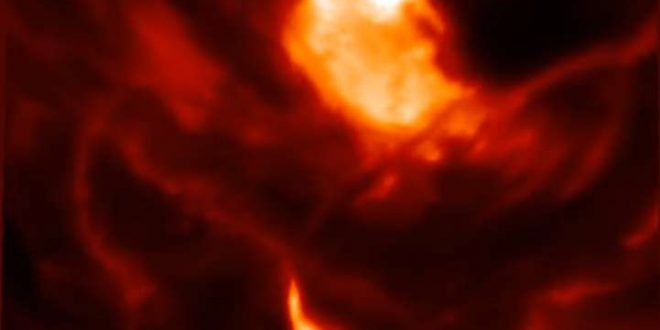Largest solar flare in 12 years – and eighth largest since modern records began in 1996 – observed in high detail from Swedish Solar Telescope in La Palma.
The huge burst of radiation, which was not harmful to humans due to the Earth’s protective atmosphere and distance from the sun, occurred unexpectedly on Wednesday 6 September 2017.
The flare was one of three X-category flares – the largest type of flare – observed over 48 hour period.
The large solar bursts have energies comparable to one billion hydrogen bombs and can drive plasma away from the solar surface at speeds of up to 2000 km/s in phenomena known as coronal mass ejections.
These powerful events, known as space weather, can lead to disruption to satellites and GPS signals, as well as spectacular aurora through their interaction with the Earth’s atmosphere.
The largest X-class flare occurred at 13:00 GMT and was measured to have an energy level of X9.3 (where X9 is nine times more powerful than X1).
A team from a consortium of U.K. universities, including the University of Sheffield and Queen’s University Belfast, supported by the Science and Technology Facilities Council, observed these historic events in extremely high detail using the Swedish Solar Telescope in La Palma.
One of the most difficult aspects of flare observation using ground-based telescopes is the short time-scales over which flares evolve. X-class flares can form and reach their peak intensities in little over five minutes, meaning observers, who only see a small part of the sun at any one moment, must act fast to ensure they catch the crucial opening moments of the flares evolution.
Dr Chris Nelson from the Solar Physics and Space Plasma Research Centre (SP2RC), led by Professor Robertus von Fáy-Siebenbürgen, from the University of Sheffield’s School of Maths and Statistics, was one of the observers at the telescope.
He said “It’s very unusual to observe the opening minutes of a flare’s life. We can only observe about 1/250th of the solar surface at any one time using the Swedish Solar Telescope, so to be in the right place at the right time requires a lot of luck. To observe the rise phases of three X-classes over two days is just unheard of.”
Dr Aaron Reid, a research fellow at at Queen’s University Belfast’s Astrophysics Research Centre, added: “The sun is currently in what we call solar minimum. The number of Active Regions, where flares occur, is low, so to have X-class flares so close together is very usual. These observations can tell us how and why these flares formed so we can better predict them in the future.”
Using the data collected during this observation, researchers will be able to probe the conditions in the solar atmosphere as these powerful events are formed, allowing more accurate predictions about when and where X-class flares might occur in the future.
This information can be channelled into the multi-billion pound space weather industry to better protect satellites from the dangers of the sun.
Professor Robertus von Fáy-Siebenbürgen added: “We at SP2RC are very proud to have such talented scientists who can make true discoveries. These observations are very difficult and will require hard work to fully understand what exactly has happened on the sun.”
Professor Mihalis Mathioudakis, who led the project at Queen’s University Belfast, added: “Solar flares are the most energetic events in our solar system and can have a major impact on earth. The dedication and perseverance of our early career scientists who planned and executed these observations led to the capture of this unique event and have helped to advance our knowledge in this area.”
Agencies/Canadajournal

 Canada Journal – News of the World Articles and videos to bring you the biggest Canadian news stories from across the country every day
Canada Journal – News of the World Articles and videos to bring you the biggest Canadian news stories from across the country every day

